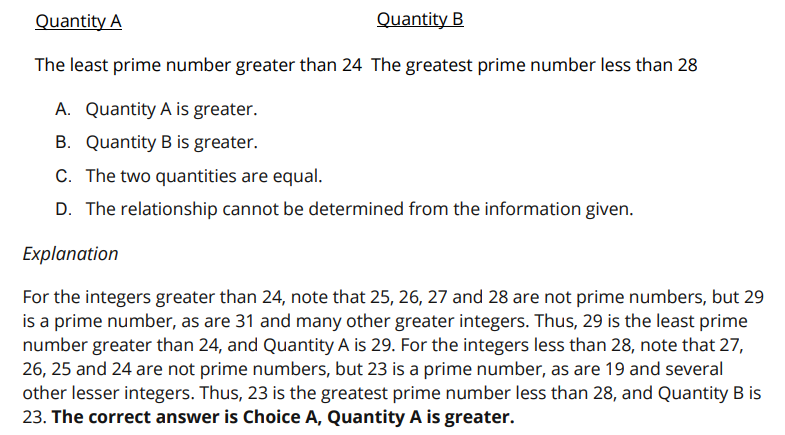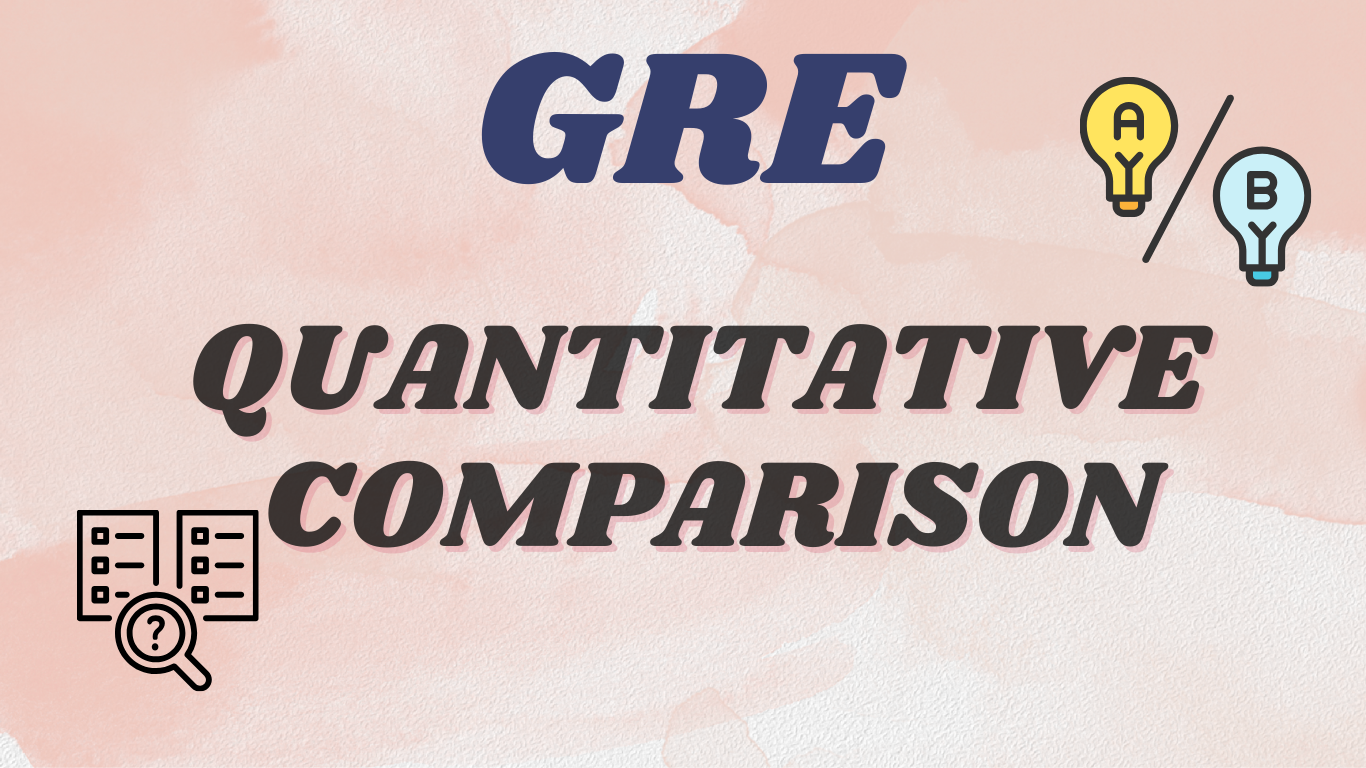What Are Quantitative Comparison (QC) Questions?
The GRE Quantitative Comparison (QC) section is one of the most unique and challenging parts of the GRE Quantitative Reasoning test. Unlike traditional math problems that require exact answers, QC questions test your ability to analyse and compare two mathematical expressions quickly and efficiently.
Quantitative Comparison questions present two quantities, labelled Quantity A and Quantity B. Instead of solving for a specific value, you must determine the relationship between the two.
Every QC question has the same four answer choices:
- (A) Quantity A is greater.
- (B) Quantity B is greater.
- (C) The two quantities are equal.
- (D) The relationship cannot be determined from the given information.
These questions assess your ability to use logical reasoning, estimation, and number properties rather than detailed calculations.
Question Structure
GRE Quantitative Comparison (QC) questions follow a standardized format:
You are given two mathematical expressions:
- Quantity A
- Quantity B
Your task is to determine the relationship between them and choose one of the four fixed answer choices:
- (A) Quantity A is greater.
- (B) Quantity B is greater.
- (C) The two quantities are equal.
- (D) The relationship cannot be determined from the given information.
The key challenge is that you don’t need to solve for exact values. Instead, you must compare the quantities using estimation, algebraic manipulation, number properties, and logical reasoning.
Examples of Typical QC Questions
Quantitative Comparison questions cover a wide range of mathematical concepts, but they generally fall into three main categories:
1. Algebra-Based Comparisons
These questions involve algebraic expressions, equations, and inequalities.
Example:
If x>0, compare:
- Quantity A: x^2 + 2x
- Quantity B: 3x
2. Geometry-Based Comparisons
These questions test knowledge of geometric properties, such as areas, perimeters, angles, and triangle inequalities.
Example:
A circle has a radius r, and a square has a side length s. Compare:
- Quantity A: The area of the circle.
- Quantity B: The area of the square.
3. Number Property-Based Comparisons
These questions test odd/even properties, prime numbers, absolute values, exponents, fractions, and divisibility rules.
Example:
If x is a nonzero integer, compare:
- Quantity A: x^3
- Quantity B: x

Key Strategies for Solving QC Questions Efficiently
Simplify the Expressions
- Factor, cancel, or rewrite algebraic expressions before comparing.
- Example: Instead of solving x^2 - 4 = 0, factor it as (x−2)(x+2)=0 to quickly analyse values.
Test Multiple Values for Variables
- Consider positive, negative, fractional, and zero values.
- Example: If x is an integer, test values like -2, -1, 0, 1, and 2 before drawing conclusions.
Recognize Number Properties and Mathematical Patterns
- Squaring always produces a non-negative result.
- Odd minus even is always odd.
- Exponential functions grow faster than polynomials (e.g., 2^x vs. x^2).
Estimate Instead of Calculating
- If comparing fractions, use approximation (e.g., 49/100≈0.49 is smaller than0.5).
- Use bounds for square roots and exponents instead of solving exactly.
Recognize When Answer Choice (D) is Correct
- If different values lead to conflicting relationships, the answer must be (D).
- Example: x^2 vs. x produces different results for x=1 vs. x=−1.
Avoid Unnecessary Calculations
- Look for comparisons rather than full computations.
- Example: If one quantity is x+1 and the other is x, no need to solve—x+1 is always greater.
Manage Time Effectively
- Spend under a minute per QC question using shortcuts.
- If stuck, eliminate impossible choices and make an educated guess.
Common Mistakes in QC Questions
Over-Calculating Instead of Comparing: Spending too much time solving for exact values when an estimation would suffice.
Not Testing Different Types of Numbers: Assuming all variables are positive when they could be negative or fractions.
Misinterpreting Answer Choice (D): Thinking (D) means "I don't know," instead of recognizing that multiple cases exist.
Ignoring Mathematical Properties: Forgetting that squares are always positive, or that multiplying by a negative reverses inequalities.
Time Mismanagement: Getting stuck on difficult QC questions instead of moving forward to easier ones.
How to Avoid These Mistakes
- Think in Terms of Comparisons, Not Exact Calculations
- Always Consider Negative, Fractional, and Zero Cases
- Understand When Answer Choice (D) is the Correct Choice
- Review Common Number Properties and Theorems
- Practice Under Timed Conditions
Conclusion
GRE Quantitative Comparison questions may seem tricky at first, but with the right strategies, sharp reasoning, and smart shortcuts, you can conquer them with confidence! Instead of fearing these questions, embrace them as an opportunity to showcase your analytical thinking and problem-solving skills.
Statistically, these questions make up around 40% of the GRE Quantitative section (crunchprep.com), meaning mastering them can have a significant impact on your overall score.
Remember, the GRE isn’t just about math—it’s about thinking strategically and managing time wisely. By practicing consistently, recognizing common traps, and applying efficient techniques, you’ll turn QC questions from a challenge into an advantage.
So, stay focused, keep practicing, and trust your ability to master these questions. With dedication and the right mindset, your GRE Quantitative score is bound to soar!
Common FAQs
What are GRE Quantitative Comparison questions?
GRE Quantitative Comparison questions present two mathematical expressions (Quantity A and Quantity B), and you must determine their relationship. You choose from four answer options:
- (A) Quantity A is greater
- (B) Quantity B is greater
- (C) The two quantities are equal
- (D) The relationship cannot be determined from the given information
How are Quantitative Comparison questions different from other GRE math questions?
Quantitative Comparison questions focus on comparing two quantities rather than solving for a specific value. They assess your ability to analyze relationships and estimate values quickly, instead of requiring detailed calculations.
What is the best strategy to solve GRE Quantitative Comparison questions?
The best strategy is to:
- Simplify expressions (factor, cancel, etc.).
- Test multiple values for variables (positive, negative, zero, fractions).
- Look for patterns in numbers and properties (even/odd, square roots, etc.).
- Estimate when possible to save time.
- Consider answer choice (D) if you see conflicting relationships based on different test cases.
How can I improve my speed in solving QC questions?
To improve speed, practice under timed conditions, focus on identifying patterns, and develop mental math shortcuts. Avoid spending too much time on any single question and move on if you get stuck.
Is it always necessary to test multiple values for variables in QC questions?
Yes, testing multiple values ensures you consider all possible scenarios, especially when the relationship might change depending on the value of the variable (e.g., positive vs. negative or integer vs. fraction).
What should I do if I encounter an unfamiliar concept in a QC question?
If you encounter an unfamiliar concept, use elimination to rule out impossible answers and move on if necessary. Return to the question later if you have time.
How much do Quantitative Comparison questions impact my GRE score?
Quantitative Comparison questions make up 40% of the GRE Quantitative section, making them crucial for achieving a strong score. Mastering these questions can significantly impact your overall performance. (source)
What’s the most common mistake test-takers make on GRE Quantitative Comparison questions?
The most common mistake is over-calculating instead of focusing on comparisons. Many test-takers waste time solving for exact values, when logical analysis or estimation would be more efficient.
